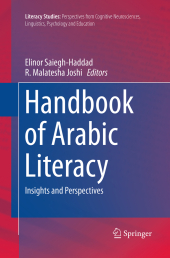 Neuerscheinungen 2016Stand: 2020-02-01 |
Schnellsuche
ISBN/Stichwort/Autor
|
Herderstraße 10
10625 Berlin
Tel.: 030 315 714 16
Fax 030 315 714 14
info@buchspektrum.de |

R. Malatesha Joshi, Elinor Saiegh-Haddad
(Beteiligte)
Handbook of Arabic Literacy
Insights and Perspectives
Herausgegeben von Saiegh-Haddad, Elinor; Joshi, R. Malatesha
Softcover reprint of the original 1st ed. 2014. 2016. xxiii, 422 S. 134 SW-Abb., 58 Tabellen. 235 mm
Verlag/Jahr: SPRINGER NETHERLANDS; SPRINGER 2016
ISBN: 9402403108 (9402403108)
Neue ISBN: 978-9402403107 (9789402403107)
Preis und Lieferzeit: Bitte klicken
This book focuses on the interplay between the linguistic and orthographic structure of Arabic and the development of reading and writing/spelling. It addresses the socio-cultural, political, and educational milieu in which Arabic literacy is embedded.
This book provides a synopsis of recently published empirical research into the acquisition of reading and writing in Arabic. Its particular focus is on the interplay between the linguistic and orthographic structure of Arabic and the development of reading and writing/spelling. In addition, the book addresses the socio-cultural, political and educational milieu in which Arabic literacy is embedded. It enables readers to appreciate both the implications of empirical research to literacy enhancement and the challenges and limitations to the applicability of such insights in the Arabic language and literacy context. The book will advance the understanding of the full context of literacy acquisition in Arabic with the very many factors (religious, historical, linguistic etc.) that interact and will hence contribute to weakening the anglocentricity that dominates discussions of this topic.
Preface: Yasir Suleiman.- Foreword: David Share.- Introduction: Elinor Saiegh-Haddad& R. Malatesha Joshi.- PART ONE: THE ARABIC LANGUAGE. Chapter 1: The Structure of Arabic Language and Orthography: Elinor Saiegh-Haddad & Roni Henkin-Roitfarb.- PART TWO: ARABIC LEXICAL REPRESENTATION AND PROCESSING. Chapter 2: Is the Arabic Mental Lexicon Morpheme-based or Stem-based? Implications for Spoken and Written Word Recognition: Sami Boudelaa.- Chapter 3: Word Recognition in Arabic: Approaching a Language-Specific Reading Model: Gunna Funder Hansen.- Chapter 4: Why is it Hard to Read Arabic?Zohar Eviatar & Raphiq Ibrahim .- PART THREE: ARABIC READING AND SPELLING DEVELOPMENT AND DISORDERS. Chapter 5: An Epidemiological Survey of Specific Reading and Spelling Disorders in Arabic Speaking Children in Egypt: Wessam Mohamed, Karin Landerl & Thomas Elbert.- Chapter 6: Types of Developmental Dyslexia in Arabic: Naama Friedmann & Manar Haddad-Hanna.- Chapter 7: Narrative Development in Arabic: Story Re-telling: Dorit Ravid, Dina Naoum & Suheir Nasser.- Chapter 8: Cognitive Predictors of Early Reading Ability in Arabic: A Longitudinal Study from Kindergarten to Grade 2: Hanadi Abu Ahmad, Raphiq Ibrahim & David L. Share.- PART FOUR: ARABIC DIGLOSSIA, LANGUAGE AND LITERACY. Chapter 9: The Effect of Diglossia on Literacy in Arabic and Other Languages: John Myhill.- Chapter 10: Acquiring Literacy in a Diglossic Context: Problems and Prospects: Elinor Saiegh-Haddad & Bernard Spolsky.- Chapter 11: A New Look at Diglossia: Modality-Driven Distinctions between Spoken and Written Narratives in Jordanian Arabic: Lior Laks & Ruth A. Berman.- Chapter 12: Literacy Acquisition and Diglossia: Textbooks in Israeli Arabic-speaking Schools: Judith Rosenhouse.- Chapter 13: Diglossic Knowledge Development in Typically Developing Native Arabic-speaking Children and the Development of ADAT (Arabic Diglossic Knowledge and Awareness Test): Reem Khamis-Dakwar & Baha Makhoul.- PART FIVE: ARABIC EMERGENT LITERACY: SOCIO-CULTURAL FACTORS. Chapter 14: The Development of Young Children´s Arabic Language and Literacy in the United Arab Emirates: Sana Tibi & Lorraine McLeod.- Chapter 15: Mother-Child Literacy Activities and Early Literacy in the Israeli Arab Family: Ofra Korat, Dorit Aram, Safieh Hassunha-Arafat, Himat Hag-YehiyaIraki & Elinor Saiegh-Haddad.- PART SIX: ARABIC LITERACY DEVELOPMENT IN SPECIAL POPULATIONS. Chapter 16: Environmental Contributions to Language and Literacy Outcomes in Bilingual English-Arabic Children in the U.S.A.: Lama K. Farran, Gary E. Bingham & Mona W. Matthews.- Chapter 17: The Development of Grapho-phonemic Representations among Native Hebrew Speakers Learning Arabic as a Foreign Language: Susie Russak & Alon Fragman.- Chapter 18: Braille Reading in Blind and Sighted Individuals: Educational Considerations and Experimental Evidence: Waleed Jarjoura & Avi Karni.- Subject Index.- Author Index


